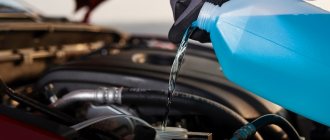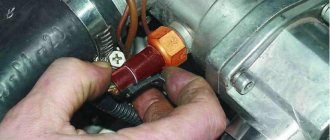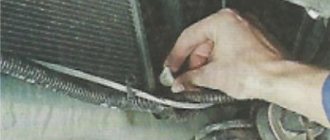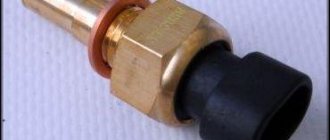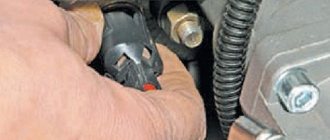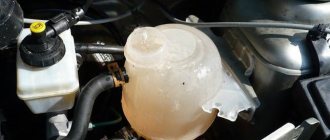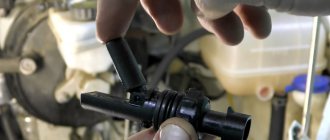According to the recommendation of the AvtoVAZ manufacturer, the coolant in the VAZ 2101-2107 engine must be replaced every 2 years or 45,000 km. Of course, many owners of “classics” do not adhere to this rule, but in vain. Over time, the cooling and anti-corrosion properties deteriorate, which can lead to corrosion in the channels of the block and cylinder head.
In order to drain antifreeze or antifreeze on a VAZ 2107, you will need the following tool:
- Open-end wrench 13 or head
- Sling on 12
- Flathead or Phillips screwdriver
So, before starting this work, it is necessary that the engine temperature is minimal, that is, there is no need to warm it up before this.
First of all, we place the car on a flat, flat surface. The heater control damper must be in the “hot” position. It is at this moment that the heater valve is open and the coolant should completely drain from the heater radiator. Open the hood and unscrew the radiator cap:
We also immediately unscrew the cap from the expansion tank so that the coolant drains from the block and radiator faster. Then we place a container of about 5 liters under the drain hole of the cylinder block and unscrew the bolt, as shown in the photo below:
Since it is quite inconvenient to substitute a large container, I personally took a 1.5 liter plastic bottle and substituted it:
We also unscrew the radiator cap and wait until all the antifreeze or antifreeze drains from the cooling system:
After that, screw back all the plugs except the filler plug and fill the radiator with new antifreeze to the top edge. After this, you need to fill the coolant into the expansion tank. To avoid the formation of an air lock in the cooling system, you need to disconnect the expansion tank hose, as shown in the picture below:
Now we lift the expansion tank up and fill in a little antifreeze so that it flows through the other end of the hose. And at this time, without changing the position of the tank, we put the hose on the radiator. We continue to hold the tank at the top and fill it with antifreeze to the required level.
We start the engine and wait until the radiator fan comes on. Then we turn off the engine when the fan stops working, and after the engine has completely cooled down, we check the antifreeze level in the conservator again. Top up if necessary!
Coolant regulates many important processes in a car. For example, it cools the motor, it affects the temperature sensor and its indicators (during normal operation, the indicator should be at a low level). And in order to maintain all these processes normally, the VAZ 2106 antifreeze must be replaced on time.
Coolant Application
- To maintain normal temperature (sensor) during engine operation.
- To maintain a low temperature (sensor) in the gearbox.
- For lubricating the water pump located in the engine.
- For heating the interior in winter cold.
Replacing antifreeze or antifreeze in a VAZ 2106 car should be done every 45 thousand km or once every two years, depending on the circumstances. Replacement must be made because this substance, like many others, loses its properties over time and succumbs to corrosion. In order to avoid this, you need to change it in time.
A little theory
To transmit force, one of the properties of the fluid is used - its incompressibility. That is, when a force is created on a liquid, its volume does not change, and it acts as a transmitter.
A hydraulic brake drive is more practical than a mechanical or pneumatic one, but it has one drawback - if air gets into the fluid, the transmission of force will be significantly reduced. This is because air, like any gas, is compressible. As a result, the presence of air leads to a change in the volume of the liquid when creating force (due to gas compression). Because of this, the force is no longer transmitted to the actuators, since it is absorbed by the volume change.
It turns out that effective operation of the brakes on a VAZ occurs only until air enters the drive system. And this can happen for several reasons.
Article on the topic - The design of the VAZ brake system
How to change coolant
Before replacing the coolant, you need to figure out how to fill it correctly, where, what quantity is needed and what brand. The draining and filling of this substance occurs in the expansion tank, which is located in the engine compartment on the left side of the mudguard on a bracket and secured with clamps.
You will need a volume of 10 liters of antifreeze or antifreeze. Which is better for you? According to reviews, the first one slightly exceeds the indicators; it is also sold in a ready-made form, or it needs to be diluted in a simple proportion (50 to 50). Choose a high-quality and reliable brand.
Before replacing, do not forget to check the temperature indicator (sensor). It is the first criterion that signals immediate replacement. If the temperature is above normal, then start measuring the level. For this:
- Unfasten the rubber strap.
- Unscrew the tank cap and look at the mark (it should be 3-4 mm higher than “min”).
If the level is below normal, then it’s time to start replacing.
Lada 1995, 71 l. With. — consumables
Shawls
Lada 2105, 2010
98 000 ₽
Mogocha
Lada 2105, 2004
75 000 ₽
Mound
Lada 2105, 2003
44 000 ₽
Irkutsk
Lada 2105, 1997
47 000 ₽
See more cars on Drome
Participate in the discussion can only registered users.
Login Register
This is interesting: How much oil is in the box of Priora 2
Drain
To get started, make sure you have all the necessary tools:
- key or head;
- screwdriver;
- container for draining;
- stock of new coolant.
Removing the radiator cap
If your engine is cool, you can start working right away.
- Park the car on a level road.
- Open the hood and remove the radiator cap.
- Unscrew the cap from the tank.
- Place a container for draining (one that can hold at least 5 liters).
- Unscrew the bolt and also the radiator cap. Now you can drain everything.
The thermostat is the boss
Not a very pleasant breakdown, especially if it happens on the road. And if the engine is boiling due to a faulty thermostat, then there is only one way out - to change this element of the system. True, at first you can slightly “reanimate” him; for this you need to apply several sharp blows to his body with something heavy.
But such a “rough” solution may not always help. There will be much more trouble if liquid leaks out of the tank. The thermostat allows the system to switch the circulation of liquid between two circles - large and small. These circles differ in that in the first one a radiator is connected to the cooling process. And if it does not connect, then the liquid boils.
On VAZ 2107 cars, and indeed on all cars of this manufacturer, the thermostat fails in such a way that the antifreeze continues to circulate in a small circle. And even if you turn on the radiator fan with the button, this will not save the situation.
The car still drives poorly, the antifreeze boils, and you won’t be able to immediately understand why this is happening. And the answer is very simple - to increase the life of the thermostat, do not pour running water into the system. Use any antifreeze, in particular antifreeze. The water leaves a large amount of scale, which interferes with the movement of the thermostat element.
Fill in
If the first part of the procedure was successful, then you can safely proceed to the second.
- Tighten the bolt.
- Fill the radiator with the required amount of antifreeze or antifreeze.
- Remove the hose and let the substance flow into it so that it flows out the other side. Lift the tank, insert the hose and pour in completely.
- Turn on the engine before the fan starts.
- Turn it off and check the sensor and level.
- Now tighten the radiator cap and tank cap. Screw on the cap and close the hood.
Done, the replacement in the VAZ 2106 was completed successfully.
The device of the working cylinder in a VAZ
In classic VAZ 2106, 2101, 2107 models, the clutch consists of two cylinders - the main and the working. Essentially, they do the same job. The clutch slave cylinder in the VAZ 2106, 2101, 2107 is located near the vehicle’s gearbox - in these models there are no significant differences in the structure of the part. It is secured to the box body with several bolts. The location of the part in these VAZ models is designed in such a way that it can only be seen from below the car.
When you press the clutch pedal, a piston moves inside the master cylinder, causing the brake fluid to be pushed out. After this, the brake fluid passes through the entire cylinder and, under the influence of the created pressure, exerts work on the same piston, which in turn presses on the fork in the cylinder. Both clutch cylinders of the car are dependent on the presence of brake fluid.
Therefore, it is very important to check the presence of this fluid in the tank, which is located under the hood of the car, and not allow it to drop to a critical level.
It often happens that liquid leaks. This happens due to wear of parts or due to the use of brake fluid that is not intended for VAZ cars. For VAZ 2106, 2101, 2107 models, the DOT-3 brand is used. The use of another type has a bad effect not only on the clutch slave cylinder, but also on the main one.
There are also cases when the master cylinder may also be the result of a clutch failure in a VAZ car - such a failure is very easy to notice. It is enough to open the hood of the car and look at the reservoir into which the brake fluid is poured. There will be noticeable drips at the junction of it with the cylinder. In this case, you need to tighten the bolts. If the fluid continues to leak, then it is necessary to use a repair kit or replace the part completely.
Why does it flow
If the lubricant level in your VAZ 2106 car begins to decrease, then there is a high probability that a leak has occurred and before changing it, you need to “patch” the leak site. Finding it is sometimes not very easy. Try searching in places like:
- clamps (it is possible that they are not clamped well);
- radiator (mechanical damage);
- pump (pump worn out);
- leakage from under the head;
- leak into the cabin.
In some cases, you will have to replace the part, in others you will just have to screw it in, seal it and weld it, but there are also cases when the matter requires serious repairs and you will have to take the car to a service center. Therefore, pay close attention to your car and monitor the level and temperature.
Heat removal mechanism repair
Before you begin repairing the cooling system, you need to find out the volume of liquid poured into it. But even completely draining the old antifreeze, it will not be possible to fully establish the exact figure. To do this, it is still recommended to refer to the vehicle’s operating manual, where all the necessary regulations and parameters are indicated.
The manufacturer assures that the working volume of the VAZ-2106 engine cooling system is nine liters, but it is worth considering that you need to add about a liter to this volume in order to add antifreeze to the expansion tank to the minimum mark. In addition, a thrifty and prudent driver must have a spare liter container of coolant in the trunk.
Cooler drain
Before any operation on the cooling system, you must first allow the engine to cool to avoid serious injury. Then the liquid filling the system will need to be drained. To do this correctly, you have to figure out how it works.
The cooling system has two stages of operation. They can be called cycles and divided into two circles:
- Big.
- Small.
The small circle is limited by the engine itself and some pipes, and it is intended to ensure that the engine quickly reaches the temperature necessary for proper operation
This is important so that the fuel mixture burns more efficiently with a higher efficiency. When the temperature rises to a certain point, a special valve opens, releasing liquid in a large circle
The purpose of this cycle is to directly cool to an acceptable temperature.
The large circle includes a radiator with a fan, which is turned on by a special thermostat and the air flow cools the system and the engine. All liquid is driven by a pump or pump. It also creates the required pressure in the cooling system.
First of all, the antifreeze is drained from the large circle through the radiator, in the left corner of which there is a special drain valve. To do this, you need to prepare a special container with a wide neck. Then a special plug is unscrewed from the engine itself and drainage occurs from the small circle, that is, directly from the engine.
Correct refilling with antifreeze
After completing the necessary work, all drain holes are closed, and the pipes are put in place, and the VAZ-2106 antifreeze is replaced. The liquid that was drained into the container can be reused by carefully filtering it through cheesecloth before doing so. The cooling system is refilled through the expansion tank.
Before refueling, it is necessary to measure the required amount in order to control the filling of the system. After the engine warms up, the liquid will again leave the expansion tank, which will mean filling a large circle with antifreeze. Next, all that remains is to add the missing liquid to the minimum mark. Overflowing above the level is not recommended, since antifreeze expands when heated, and the pipes or expansion tank may not withstand the pressure created by the pump! After refueling is completed, you must ensure that the cooling system is tight and there are no leaks.
The operation of replacing the coolant in a VAZ-2106 is not that complicated, but it will help you save some time, money, and most importantly, you will have confidence that the work was done efficiently.
Video “Draining the coolant”
Good afternoon, today we will tell you how to independently replace the coolant in a VAZ-2107 (or any other classic). There is nothing complicated in the procedure for replacing antifreeze in the engine cooling system, the main thing is to adhere to the following recommendations - perform the operation of draining the antifreeze only on a cold engine, you can on a warm one, but in no case on a hot one, this is dangerous, just trying to unscrew the radiator neck cap If it's hot, it can cause burns. So let's get started. We will assume that the engine has already cooled down and we are ready to drain the coolant. We will need a 13 key to unscrew the plug on the block and a 22 key to unscrew the plug or sensor at the bottom of the radiator, depending on the model and configuration of your classic. We also need the antifreeze itself, we used the following coolant:
First of all, unscrew the cap on the radiator neck. Then the antifreeze will drain much faster.
Then unscrew the coolant temperature sensor at the bottom of the radiator:
Or a faucet, depending on the modification of your car (different classic models use different types of radiators)
After the antifreeze has drained from the radiator, or without even waiting for it to finish, unscrew the 13 plug on the block with a wrench:
After all the coolant has drained from both the block and the radiator, we screw back the sensor (plug) and the plug on the block, pull it through carefully, and proceed to filling in new antifreeze. We fill it through the filler neck on the radiator. And here’s another little secret - in order to avoid air locks after filling in new coolant, you need to unscrew and throw off this hose, shown below in the photo:
and pour antifreeze into the system until excess coolant begins to drain from it. That's all, congratulations, you have learned how to change the coolant in your classic , and you have learned how to do this without air locks in the system. If you still have any questions about this procedure, we are waiting for you in our VAZ classic club on the forum .
Features of antifreeze and antifreeze
For starters, Antifreeze. This is a type of antifreeze developed in the USSR. But, as often happens with us, the name has become a household name, and many liquids for automatic cooling systems are called Tosol.
Antifreeze and antifreeze are based on ethylene glycol (less commonly propylene glycol), distilled water and various additives. And the main difference between them is only in the package of additives.
Antifreeze is made from equal parts of water and ethylene glycol using traditional technology, which includes additives based on salts of inorganic acids.
But antifreeze already includes carboxylate additives (from salts of organic acids).
Thanks to additives, these liquids have anti-cavitation, anti-foam and anti-corrosion properties.
But the traditional production technologies used in the production of Tosol are somewhat outdated due to additives. Additives made from salts of inorganic acids cease to perform their functions over time. Antifreeze has a longer additive life.
In this case, the supplements themselves work differently . The anti-corrosion additive in Antifreeze covers all metal elements of the system with a thin protective layer. But this same layer also makes it difficult for heat to dissipate.
In antifreeze, this layer is much thinner than in antifreeze, and at the same time covers only those elements of the system that are susceptible to corrosion.
The fact is that most domestic cars are primarily designed to work with Tosol. This is the basic fluid, although often the instructions for use will indicate that you can use antifreeze.
Possibility of tuning the VAZ 2107 cooling system
You can increase the efficiency of the VAZ 2107 cooling system in various ways. Someone installs a fan from a Kalina or Priora on the radiator, someone tries to better heat the interior by adding an electric pump from a Gazelle to the system, and someone installs silicone pipes, believing that with them the engine will warm up faster and cool down. However, the feasibility of such tuning is highly questionable. The cooling system of the VAZ 2107 itself is quite well thought out. If all its elements are in good working order, the engine will never overheat in the summer, and in winter the cabin will be warm even without turning on the heater fan
To do this, you only need to periodically pay attention to system maintenance, namely:
- fill only high-quality coolant into the engine;
- change the coolant every 50 thousand km with a complete drain and flushing of the system;
- monitor the coolant level and add it if necessary;
- When topping up, never mix antifreeze with antifreeze;
- When replacing faulty elements, use only high-quality certified parts.
Thus, the cooling system of the VAZ 2107 is quite reliable and simple. However, it also needs periodic maintenance, which even an inexperienced car enthusiast can perform.
We perform pumping correctly
Bleeding the clutch must be done immediately after replacing the working cylinder, as well as when the level of brake fluid in the reservoir is low. Work is carried out on bleeding in VAZ 2106, 2101, 2107 cars through a fitting located on the working cylinder.
First, fill the brake fluid reservoir full. Find a partner for this job who will press the clutch pedal inside the car. Take the hose and put it on the fitting of the slave cylinder, then tell your partner to depress the clutch pedal several times. After this, let him press the pedal all the way and do not let go, at this time you should slightly loosen the nut on the fitting to release some liquid and air.
This procedure must be repeated until there are no air bubbles in the liquid flowing out of the hose. After that, add it to the middle mark in the tank and check from time to time to see if it goes away.
Principle of operation
The main place in a car is not the driver’s seat or even the steering wheel, but the engine. It is even called the heart. And this is not without reason, because the correct functioning of this heart directly determines whether the car will go or not. And in order not to destroy such an important technical unit, it is necessary to maintain a certain temperature and cool it in time.
The operating principle of this system is quite simple, but at the same time technically well thought out. It is connected by pipes to the engine itself, the radiator and the interior heater
To understand the importance of these elements, you need to know their main functions:
- Maintaining the required temperature.
- Engine cooling.
- Warming up the car interior.
In the first case, for engine operation and proper combustion of the fuel mixture, a certain and stable temperature is required. If it is higher or lower, it has a very bad effect on the engine. In the second case, the engine is protected from overheating, which can lead to deformation of some parts inside.
Types of coolants
To absorb heat and remove it from hot spots in the engine, the system requires coolant. There are several types of cooling liquids:
- Water.
- Antifreeze.
- Antifreeze.
But in the harsh realities of the Russian climate, the use of water as a coolant is impractical. And it boils away very quickly, having a rather low thermal conductivity. You don’t even need to mention how it affects the occurrence of corrosion.
Antifreeze is the most common among domestic car owners, but it has some disadvantages, for example, the formation of an oil film inside the vessels and pipes, which prevents normal heat transfer. Accordingly, heat removal becomes ineffective.
The third option has more pros than cons. Firstly, antifreeze begins to crystallize at very low temperatures, that is, it does not freeze, which is why it got its name. This advantage allows the use of antifreeze even in the Far North. Secondly, the thickness of the oil film formed inside the vessels is very small, thanks to which almost nothing interferes with the transfer of heat. This is achieved due to the fact that antifreeze, unlike antifreeze, is made from organic components.
The main disadvantage of antifreeze is its price, especially if you need to replace the entire fluid. Antifreeze wins here, and it is more rational to use it in car models such as the VAZ-2101 or VAZ-2106. In models of the domestic automobile industry with impressive age and mileage, the cooling system often becomes a sore and vulnerable spot. Therefore, the owners of these cars need to know the principle of operation of the cooler and understand how to repair it, which will help avoid spending on services and auto repairmen.


